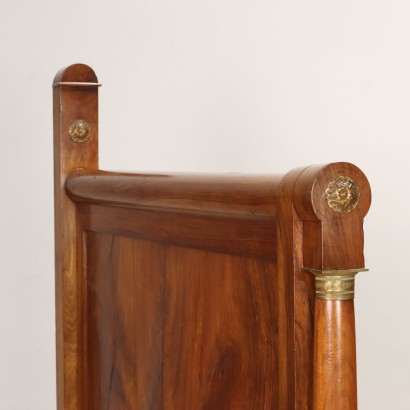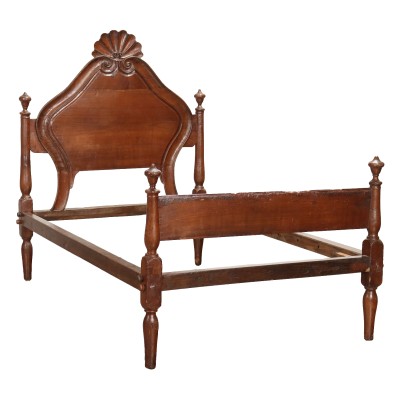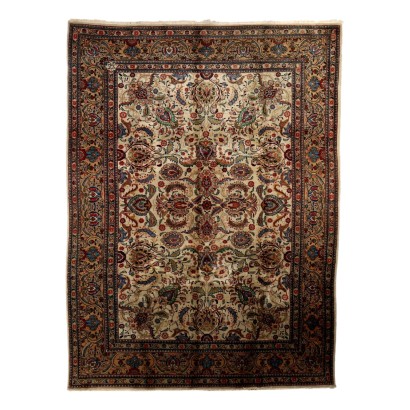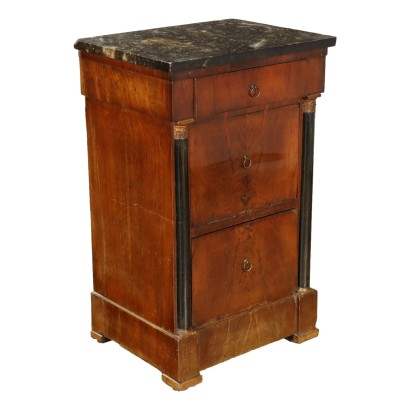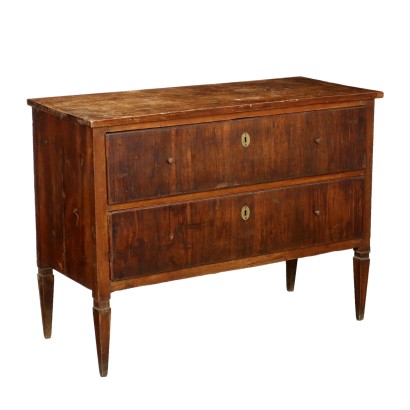Antique Empire Bed Gilded Bronze Italy XIX Century - Italy, Early XIX Century
Features
Italy, Early XIX Century
Style: Empire (1804-1815)
Age: 19th Century / 1801 - 1900
Origin: Italy
Main essence: Walnut
Material: Gilded Bronze
Description
Empire bed supported by pinto feet and characterized by asymmetrical uprights: higher on one side, lower, but with columns on the other; in walnut, it has gilded bronze decorations.
Product Condition:
Product which due to age and wear requires restoration and re-polishing. We try to present the real state of the furniture as completely as possible with photos. If some details are not clear from the photos, what is stated in the description applies.
Dimensions (cm):
Height: 52
Width: 186
Depth: 122
Bed frame maximum sizes (cm):
Height: 143
Width: 200
Depth: 139
Additional Information
Style: Empire (1804-1815)
Decorative style of the furniture that is affirmed under the Empire of Napoleon Bonaparte, that is, between 1799, the year of his election as consul, and 1815, the year of his definitive defeat.It has many elements of continuity with the previous Direttorio style, in the more general Neoclassical climate, which derived from the study of classical antiquity the forms and models to be inspired in the creation of furniture.
The peculiar feature of this style is a greater grandeur and courtesy of the furnishings, which had to convey the grandeur of the French nation to the world, hence the name Empire style.
The furniture is characterized by straight, majestic and massive lines, adorned with motifs dear to Napoleon such as bees, eagles, large Ns surrounded by laurel, and, after the Egyptian campaign, many elements taken from Egyptian art.
He prefers the flat bronze decorations, often gilded, to the refined carvings of previous years.
The typical essence of Empire furniture is mahogany.
Find out more with our insights:
Classic Monday: How society influences the taste in furnishings
Classic Monday: Empire, one style of furniture with political purposes
Classic Monday: in the Empire bed roots of culture
Classic Monday: the timeless charm of a toilet Empire
Age: 19th Century / 1801 - 1900
19th Century / 1801 - 1900Main essence: Walnut
Walnut wood comes from the plant whose botanical name is juglans regia , probably originally from the East but very common in Europe. Light or dark brown in color, it is a hard wood with a beautiful grain, widely used in antique furniture. It was the main essence in Italy throughout the Renaissance and later had a good diffusion in Europe, especially in England, until the advent of mahogany. It was used for solid wood furniture and sometimes carvings and inlays, its only big limitation is that it suffers a lot from woodworm. In France it was widely used more than anything else in the provinces. In the second half of the eighteenth century its use decreased significantly because mahogany and other exotic woods were preferred.Material: Gilded Bronze
Other customers have searched:
Letti e testate, letto a baldacchino, testiera, talamo, alcova, culla, branda, letto..
Approfondimenti
Scopri di più sui letti antichi con gli articoli del nostro blog:
Un letto impero ci rivela le radici della nostra cultura
Un insolito Thonet
Sull'antiquariato in generale dai un'occhiata anche a:
Classic Monday: da un pezzo dei nostri magazzini alla storia dell'antiquariato
L'antiquariato dalla A alla Z: il Dizionario dell'Antiquariato
Il dizionario dell'antiquariato - Lastronatura
Il dizionario dell'antiquariato - Mascherone
Il dizionario dell'antiquariato - Natura morta
Il dizionario dell'antiquariato - Opificio
Il dizionario dell'antiquariato - Pastiglia
Il dizionario dell'antiquariato - Savonarola
Il dizionario dell'antiquariato - Rosone
Intaglio barocco con motivo a ricciolo
Approfondimenti
Scopri di più sui letti antichi con gli articoli del nostro blog:Un letto impero ci rivela le radici della nostra cultura
Un insolito Thonet
Sull'antiquariato in generale dai un'occhiata anche a:
Classic Monday: da un pezzo dei nostri magazzini alla storia dell'antiquariato
L'antiquariato dalla A alla Z: il Dizionario dell'Antiquariato
Il dizionario dell'antiquariato - Lastronatura
Il dizionario dell'antiquariato - Mascherone
Il dizionario dell'antiquariato - Natura morta
Il dizionario dell'antiquariato - Opificio
Il dizionario dell'antiquariato - Pastiglia
Il dizionario dell'antiquariato - Savonarola
Il dizionario dell'antiquariato - Rosone
Intaglio barocco con motivo a ricciolo




